Mission Profile
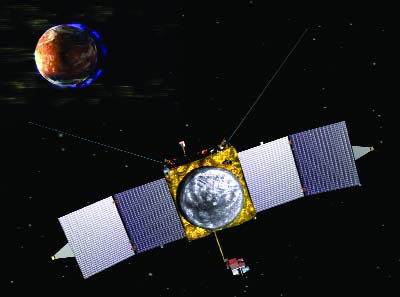
The MAVEN – Mars Atmosphere and Volatile EvolutioN Spacecraft launches atop an Atlas V 401 rocket from Space Launch Complex 41 at Cape Canaveral Air Force Station, Florida, during the 2013 interplanetary launch window. The 2013 window for the MAVEN Mission stretches from November 18 to December 7.
The Atlas V inserts MAVEN into a Hohmann Transfer orbit in which the spacecraft performs a Type-II transfer to Mars taking ten months. The cruise phase is divided into early and late cruise and features four Trajectory Correction Maneuvers as well as spacecraft checkouts and calibrations and instrument testing and science preparations.
Assuming an on-time launch, MAVEN completes its crucial Mars Orbit Insertion Maneuver on September 22, 2014 to put itself into a highly elliptical Capture Orbit. A total of five Period Reduction Maneuvers are used to lower the orbit and place MAVEN in its elliptical science orbit in which the spacecraft initially completes instrument deployments and commissioning before transitioning to science operations.
MAVEN’s primary science phase is one Earth year in duration and features a total of five Deep Dip campaigns allowing MAVEN to make measurements in the upper Martian atmosphere. After completing its primary mission, MAVEN enters its extended science phase that could continue for 29 months in the nominal science orbit before the periapse is raised to slow down orbital decay to keep MAVEN in orbit as long as six additional years. Eventually, MAVEN’s mission ends with orbital decay and entry.
Pre-Launch, Launch & Ascent
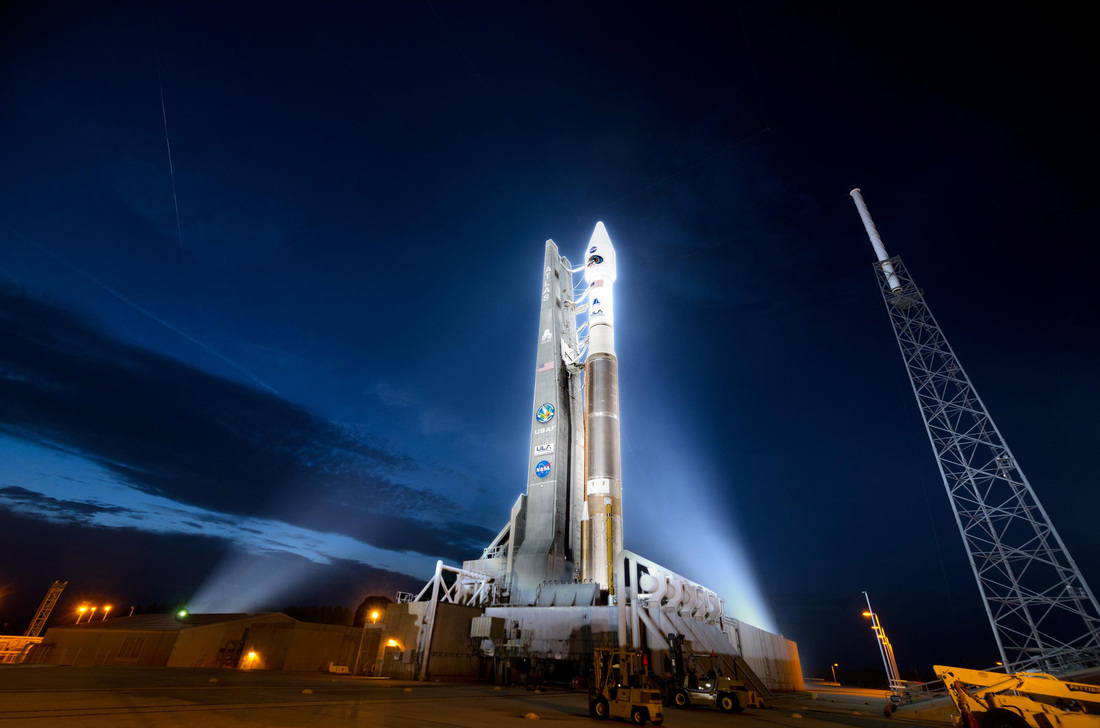
The Pre-Launch Mission Phase of the MAVEN Mission starts one day before launch and lasts until the spacecraft is transferred to internal power on launch day. At that point, final integrated testing will have been completed between the MAVEN Spacecraft and the Atlas V launcher to verify both vehicles are ready to execute their mission. Integrated Testing marks the final set of tests for the Atlas V that completes launch simulations and a Wet Dress Rehearsal after the completion of assembly.
The Atlas V with MAVEN hidden under its payload fairing is rolled out from the Vertical Integration Facility atop its Mobile Launch Platform on the day before launch.
Out at the pad, the rocket undergoes final closeouts and fueling preparations leading up to the countdown. Final activities that occur after the Atlas V is rolled out to the launch pad include final battery charging on MAVEN and health monitoring after the spacecraft is powered up.
The Atlas V 401 is the smallest of the Atlas V launcher family. The vehicle stands 58.3 meters tall, is 3.81 meters in diameter and weighs 334,500 Kilograms at liftoff. It is a two-stage rocket using a Common Core Booster as first stage and a single-engine Centaur upper stage. The rocket is topped by a 4-meter diameter payload fairing that offers sufficient space to the MAVEN spacecraft.
On Launch Day, Atlas V countdown operations get underway 7 hours ahead of the opening of the day’s launch window. Initial countdown operations include voice checks between the launch team members and the first poll of the countdown ahead of Atlas V Power-Up. Following the activation of the launcher, teams begin a series of checkouts of the electrical system of the rocket.
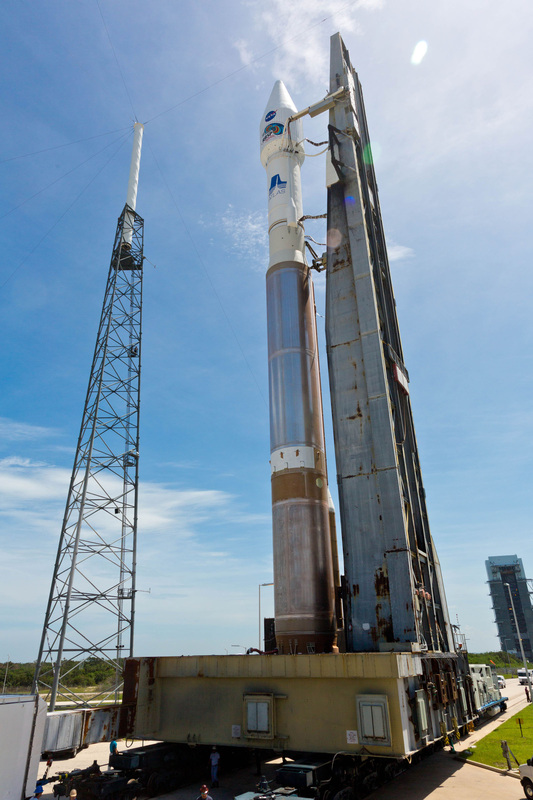
Meanwhile, at the launch pad, technicians complete final hands-on work. Those operations include close-outs of the Vertical Integration Facility, the launch pad facility and the Atlas V launcher as well as final fueling preparations.
While that is in progress, the Launch Team puts the Atlas V through a series of communications checks on its S- and C-Band Systems. Flight Termination System testing is also completed and the Nitrogen Purge flow on the vehicle is initiated. L-4 Hour commanding is performed by teams. By L-3 hours, the launch pad is cleared by all personnel.
At T-2 Hours, the countdown enters a 30-minute built-in hold during which teams perform the fueling pre-task briefing and the GO/No GO Poll for propellant loading. As soon as the countdown resumes at T-2 Hours, propellant loading operations start. The complex procedure to load the two stages of the rocket with cryogenics begins with the chilldown of ground support equipment and transfer lines and tanks chilldown on the Liquid Oxygen side.
Liquid Oxygen starts flowing into the Centaur upper stage tanks shortly thereafter. Propellant loading starts in slow fill mode until the initial portion of the tank is filled. Then, fueling transitions to fast fill until the tank reaches 95% for LOX and 97% for Liquid Hydrogen. The final part of propellant loading is completed in Topping mode. Centaur LOX loading takes about 40 minutes as 15,700 liters of –183-degree Celsius oxidizer are filled into the upper stage.
Once Centaur is into propellant loading, the large Liquid Oxygen tank of the Common Core Booster also starts fueling. LOX load on the CCB also moves through the three steps, slow-fill, fast-fill and topping. The Common Core Booster is loaded with Rocket Propellant 1 (refined Kerosene) ahead of the launch countdown. The large Common Core Booster that stands 32.46 meters tall with a diameter of 3.81m and a fuel load of 185,500 liters of LOX and 94,600 liters of RP-1.
The final tank to be loaded during the countdown is the Liquid Hydrogen Tank of the upper stage that also goes through the usual steps. Centaur is loaded with a total of 48,100 liters of -253-degree Celsius LH2 fuel. Centaur is 12.68 meters tall and 3.05 meters in diameter.
Once all tanks have reached topping, the propellant fill & drain valves go through a cycle tests to verify their condition. Also, the Atlas V launcher completes hydraulic and pneumatic system preps and pressurization. Both engines of the Atlas V, the RD-180 on the first stage and the RL-10 on Centaur, are put through a steering profile test before preparations for the automated countdown sequence begin.
Once clocks reach T-4 Minutes, the countdown enters its final built-in hold. This hold is variable in duration and can be extended in case of technical issues or uncooperative weather. During the hold, the launch team receives a final weather briefing and performs the GO/No GO Poll for Terminal Countdown.
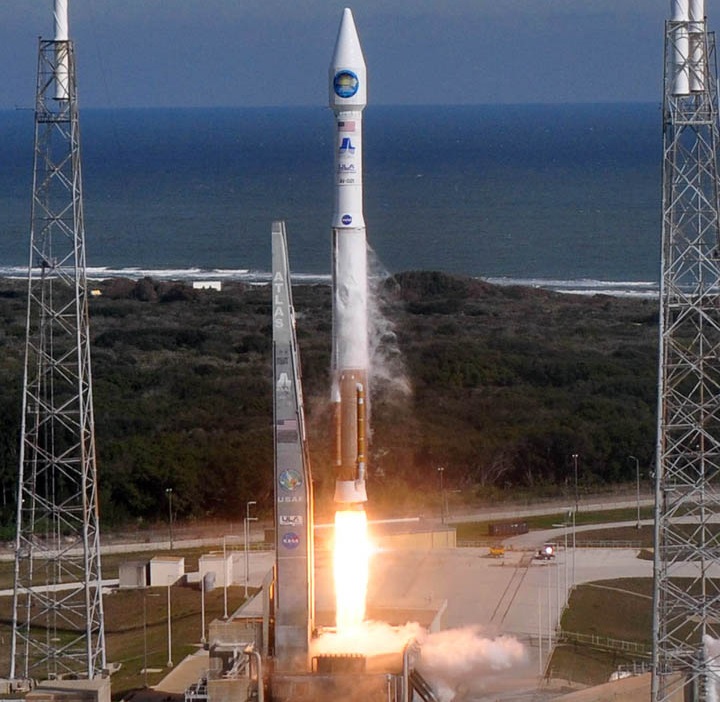
As clocks start ticking down from T-4 Minutes, final vehicle configurations such as ordnance arming, flight termination system arming, propellant tank pressurization, transfer to internal power, and flight control system reconfigurations will be made as part of the Automated Sequence to place the vehicle in its launch configuration.
At T-2.7 seconds, the massive two-chamber RD-180 main engine of the Common Core Booster ignites and soars up to its full liftoff thrust of 390,250 Kilograms. Engine start-up is closely monitored by flight computers to make sure it reaches operational conditions before the launcher is committed to flight. As clocks hit zero, the Atlas V blasts off.
Without any Solid Rocket Boosters, the Atlas V 401 makes a relatively slow initial ascent with a Thrust to Weight Ratio of 1.16. After ascending vertically for 17 seconds, the Atlas V will begin its pitch and roll maneuver to align itself with its pre-determined flight path, departing Florida’s Space Coast. After 78 seconds, the rocket passes Mach 1 followed by Maximum Dynamic Pressure about 12 seconds later. As the first stage approaches the 4-minute mark into the flight, it will start throttling down its RD-180 engine to maintain a maximum acceleration of 5 Gs.
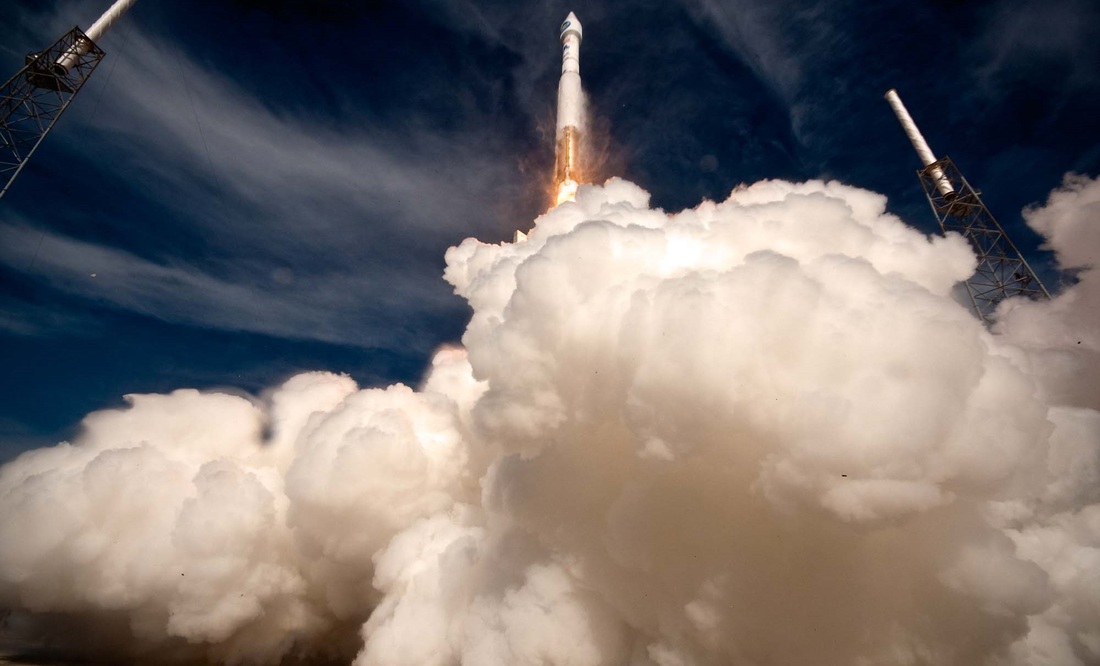
Just after passing the four-minute mark, the first stage will shut down. Six seconds after shutdown, pyrotechnics will be fired to separate the Common Core Booster that then uses eight small solid rocket motors to move away from the Centaur upper stage. Ten seconds after staging, the RL-10A engine of the Centaur Upper Stage will ignite on its first of two burns. This burn delivers the stack into a Low Earth Parking Orbit for a coast phase.
During the coast phase, the stack performs a PTC Roll to evenly distribute sun exposure on the vehicle and Centaur performs regular RCS thermal conditioning firings. The coast sets up the proper insertion conditions for the targeted heliocentric orbit. When the coast phase is complete, Centaur conducts its second main engine burn.
At the conclusion of the burn, Centaur will start a re-orientation to the proper attitude for spacecraft separation. Less than one hour after being launched, MAVEN is sent into its interplanetary trajectory.
Initial Cruise Operations
Spacecraft separation marks the beginning of MAVEN’s long journey to Mars. Shortly after separation, MAVEN initiates its solar array deployment sequence using pyrotechnic initiators. Also, the spacecraft acquires three-axis control and establishes communications with ground stations. Following insertion, MAVEN performs an initial spacecraft health check, testing all of its core functions to verify that the spacecraft was not harmed during launch and ascent.
The Launch Phase continues until L+1 day when the vehicle’s precise trajectory has been determined via ranging.
Interplanetary Cruise
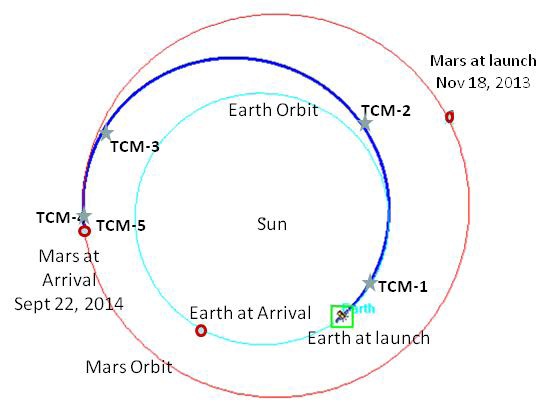
MAVEN is launched into a Hohmann Transfer Orbit with periapsis at Earth’s orbit and apoapsis at the distance of the orbit of Mars, carefully set up to intercept the planet once the spacecraft reaches apoapsis. The mission follows a Type-II trajectory as MAVEN is carried more than 180 degrees around the sun in its transfer orbit. MAVEN’s interplanetary transfer requires 10 months to set the stage for Mars Orbit Insertion in September 2014.
The Cruise Phase lasts from L+1 day to MOI-3 days and is divided into Early Cruise that is 90 days in duration and Late Cruise that takes the vehicle to the MOI Phase.
As part of Planetary Protection Rules, the MAVEN spacecraft and Centaur Upper Stage are launched into a trajectory to miss Mars by 20,000 to 30,000 Kilometers. This prevents the Centaur Upper Stage from crashing into Mars and delivering any terrestrial bacteria to the planet. To adjust its trajectory in order to target Mars, MAVEN completes a series of Trajectory Correction Maneuvers throughout its Cruise Phase.
The first major Trajectory Correction Maneuver, TCM-1, occurs approximately three weeks after launch and adjusts the orbit of the spacecraft to properly target planet Mars, correcting the built-in error for Planetary Protection and any other insertion errors that may have occurred during insertion. For this major TCM, MAVEN uses its six MR-107N main engines that provide a total thrust of 104 Kilograms. The six 22-Newton MR-106E engines are used for attitude control during the maneuver.
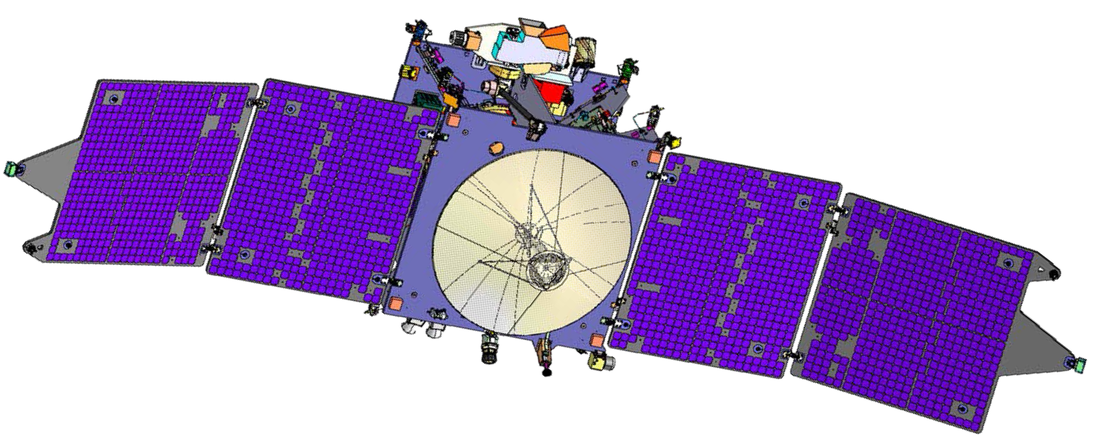
During TCM-1 which is the largest maneuver planned for the cruise, the propulsion system is operated in regulated mode. For nominal mission operations and smaller maneuvers when the MR-107N engines are not used, the system operates in blowdown mode.
The next TCM comes up in late February 2014 and corrects any residual errors from TCM-1 which are expected with a main engine burn. TCM-2 has a relatively low planned delta-v that can be accomplished by using the MR-106E thrusters as main propulsion and the 1-Newton MR-103D for attitude control.
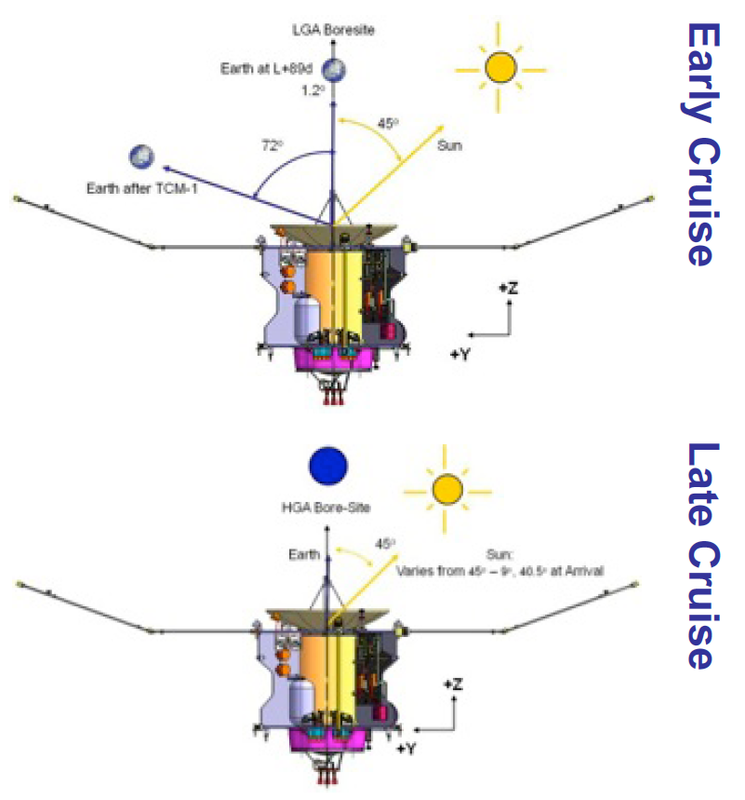
The next two TCMs are planned in mid-July and mid-September 2014. These two maneuvers are based on fine tracking data that is obtained via ranging by Deep Space Network Ground Stations. TCM-3 and 4 place MAVEN onto its final trajectory toward Mars, setting up the proper conditions for Mars Orbit Insertion.
Over the course of the cruise phase, MAVEN flies in a pre-determined attitude profile. Initially, the spacecraft cruises at a 45-degree solar angle that allows sufficient power generation and also enables Earth to slowly drift into the Low Gain Antenna boresight for continuous low-gain communications. In late Cruise, the spacecraft points its High-Gain Antenna towards Earth and allows the sun angle to drift from 45 degrees to 40.5 degrees.
In addition to the Trajectory Maneuvers, MAVEN’s cruise to Mars is filled with spacecraft and instrument testing. Although most instruments are launched with protective covers that remain in place until after MOI, electrical tests and dark measurements can be conducted during cruise. For the cruise, all instrument booms remain in the stowed position.
Following initial spacecraft health checks after launch, MAVEN undergoes detailed electrical and systems aliveness testing during the early cruise phase. In early December, the High Gain Antenna completes calibration tasks.
Throughout the rest of the month, MAVEN completes initial instrument activities that start with the activation of the Particles and Fields Package of instruments: SWEA, SWIA, STATIC, SEP, LPW & EUV, and MAG.
After power-up, the high-voltage systems of the individual instruments will be ramped up and instrument response will be assessed. Dark measurements will be made and instrument health is monitored over an extended period of time. The Magnetometer begins cruise science data acquisition at that time as well.
Later in December, the IUVS (Imaging Ultraviolet Spectrometer) instrument is activated and completes aliveness tests. Also, the NGIMS – Neutral Gas and Ion Mass Spectrometer is activated and begins functional checkouts.
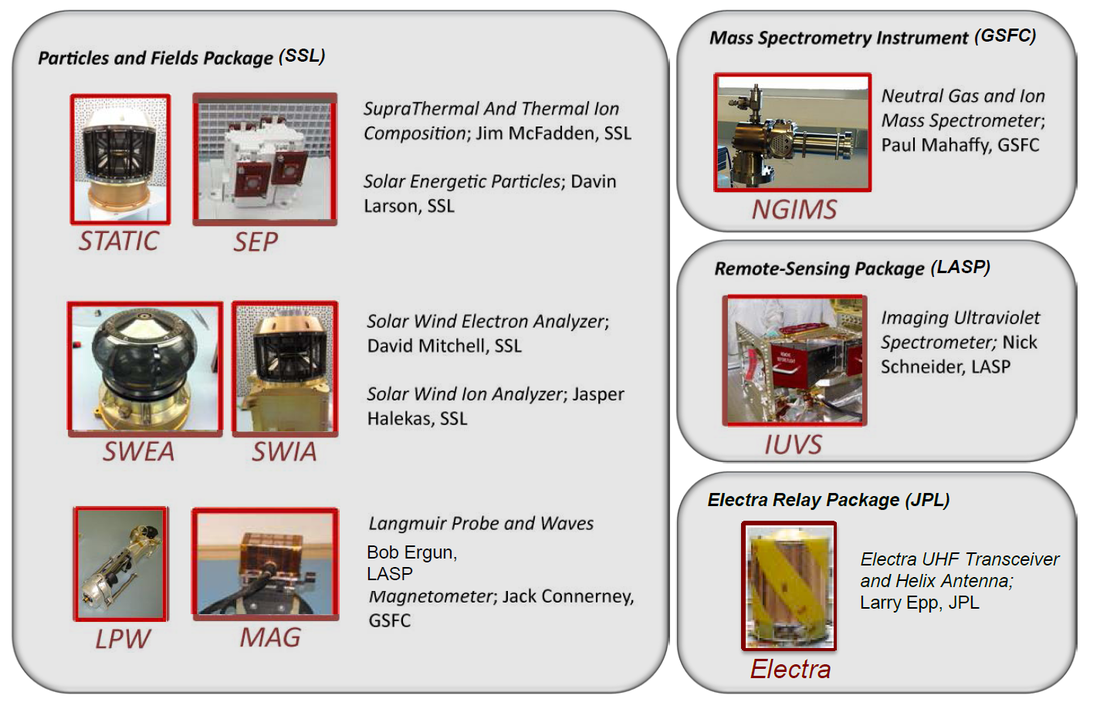
With the first round of instrument activities complete, MAVEN performs an Electra UHF Terminal checkout to verify good functionality of the system. In early January, the spacecraft completes a thruster system calibration, calibrates its attitude control system for precise sun-pointing and continues High Gain Antenna calibrations.
Three months into the mission, the spacecraft completes a slew maneuver to point its High Gain Antenna at Earth for a high-data rate communications session. This marks the transition into Late Cruise.
Later in February, the Electra UHF Terminal continues its testing sequence and the NGIMS instrument conducts another functional test.
After TCM-2, the EUV payload completes its first Cruciform Scan. The Cruciform Scan determines the EUV boresight relative to the Spacecraft Pointing Knowledge that uses star trackers. As part of the scan, the spacecraft completes a +/-4-degree scanning motion along perpendicular axes. The Cruciform Scan needs to start at the edge of the four-degree glint-free field of view of the EUV photodiodes and moves uninterrupted to the opposite site.
An uninterrupted scan in the reverse direction is required immediately to account for latency affects. Pitch and yaw scans are not coupled, but are usually completed as part of a single sequence.
After the Cruciform Scan is complete, the Inertial Measurement Unit of the spacecraft undergoes a one-time calibration activity. Later in March, the IUVS instrument completes more testing activities. Another sun-pointing calibration occurs in April and May features another round of Magnetometer operations, IUVS checks and an Electra switch exercise. After a short break in activities, the Electra completes a Self Test, NGIMS performs its third functional test and the Magnetometer continues operations. With TCM-3 in mid-July, spacecraft and payload operations enter the MOI Moratorium during which only essential spacecraft operations are performed leading up to TCM-4 and Mars Orbit Insertion.

Mars Orbit Insertion & Transition to Science Phase
The MOI Mission Phase begins about three days before the critical orbital insertion maneuver when the maneuver plan is loaded into the flight computers of the MAVEN spacecraft. A contingency Trajectory Correction Maneuver is possible as late as two days before orbital insertion in case of any larger trajectory errors. For an on time launch on November 18, 2013, MAVEN’s Mars Orbit Insertion Maneuver takes place on September 22, 2014.
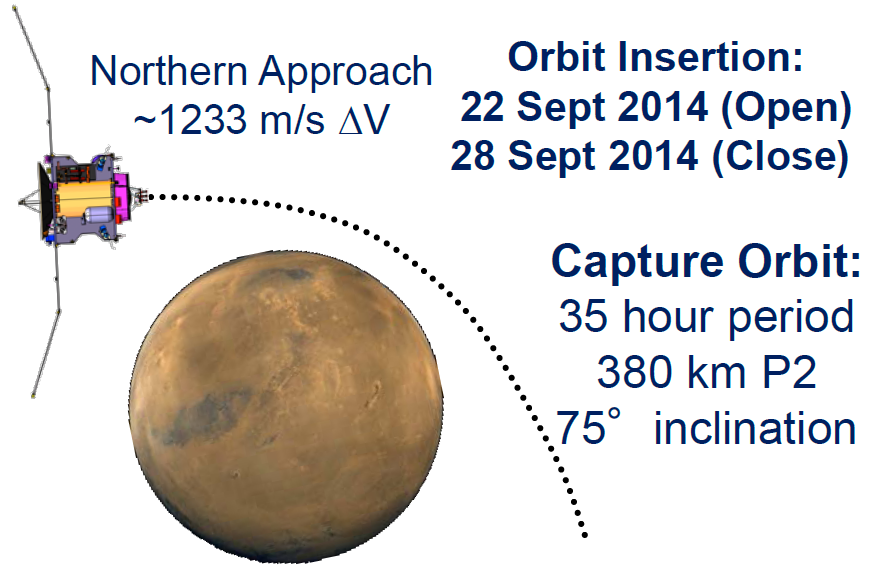
On its trajectory, MAVEN makes a northern approach before igniting its main propulsion system consisting of six MR-107N monopropellant thrusters. While the engines are firing, the six 22-Newton MR-106E engines are used for attitude control, keeping the vehicle in a retrograde orientation to insert itself into an initial Capture Orbit. For large main engine burns, the propulsion system is operated in regulated mode.
MAVEN’s MOI Burn changes the vehicle’s velocity by about 1,233 meters per second. The mission is targeting an initial orbit with a duration of 35 hours, an inclination of 75 degrees and a periapsis altitude of 380 Kilometers. MAVEN can tolerate an MOI abort followed by a system re-set and main propulsion system re-start to finish the maneuver at the expense of some extra propellant.
Shortly after insertion into the Capture Orbit, MAVEN executes a second engine burn that serves as a Period Reduction Maneuver. This burn takes place at periapsis to drastically reduce the apoapsis of the orbit, placing MAVEN in a 4.5 hour orbit.
Over the course of three weeks, MAVEN performs a series of up to four additional smaller engine burns that are conducted at apoapsis to reduce the periapsis altitude. MAVEN is targeting a science orbit of 150 by 6,200 Kilometers at an inclination of 75 degrees.
Following the insertion into the Science Orbit, MAVEN completes two weeks of instrument commissioning that begins with the methodic deployment of the vehicle’s instrument booms – the two Langmuir Probes, the SWEA instrument boom, and the Articulating Payload Platform. Also, all one-time cover deployments will be made to expose the sensors of all instruments for initial science data acquisition for commissioning.
Science Mission
The MAVEN spacecraft performs a one-year primary science mission from late October 2014 until late October 2015 followed by an extended science mission depending on vehicle performance.
Orbit Design
MAVEN’s Science Orbit was carefully designed, taking into account the science requirements of the mission and spacecraft operation limitations. The mission targets an elliptical science orbit allowing the vehicle to make in-situ measurements of the upper Martian atmosphere and more global measurements when the vehicle is farther from the planet.
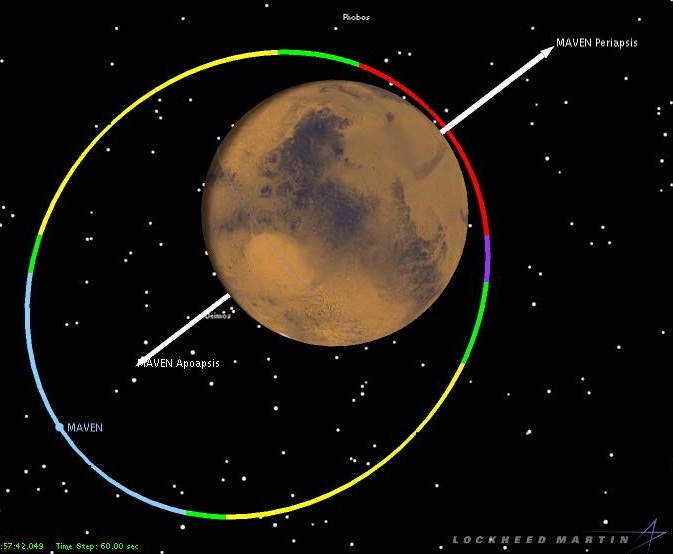
In its science orbit, the MAVEN is typically sun-pointed to charge its batteries and allow the body mounted instruments to operate. The orbit is broken into three segments – the Apoapse Segment during which the Imaging Ultraviolet Spectrometer acquires disk images, the Mid-Altitude Segments as the spacecraft is inbound & outbound during which STATIC and IUVS operations are performed, and the Periapse Segment that features the bulk of science operations using NGIMS, STATIC & IUVS.
A nominal science orbit consists of a number of phases and maneuvers to accommodate spacecraft and science activities. Starting out at Apoapse, the MAVEN spacecraft starts closing in on the planet again as it passes 6,200 Kilometers. The Apoapse Segment continues for about 45.5 minutes after which MAVEN performs a 10-minute slew to the proper attitude to set the stage for mid-altitude observations on the inbound side that takes the vehicle from an altitude of 5,000 Kilometers to 1,170 Kilometers. This segment is about 57.6 minutes in duration. Once passing 1,170 Kilometers, MAVEN starts another 10-minute re-orientation for the Periapse Segment that starts as the vehicle dips below 500 Kilometers.
The entire Periapse Segment is 22.8 minutes in duration, centered on the 150-Kilometer periapsis passage. Once passing 500 Kilometers again, MAVEN initiates a 5-minute Reaction Wheel Desaturation Sequence – using its thrusters to counteract vehicle motion while the wheels are spinning down. Afterwards, another 10-minute slew is performed to orient the spacecraft for the Outbound Segment that has a duration of 52.7 minutes, taking the vehicle from 1,570 to 5,000 Kilometers. Then, a 10-minute slew is conducted to signal the start of the Apoapse Segment at 5,400 Kilometers, requiring 45.5 minutes until the spacecraft reaches the high point of its orbit. Orbit timing is provided by an autonomous Periapsis Timing Estimator since tracking from Earth is limited.

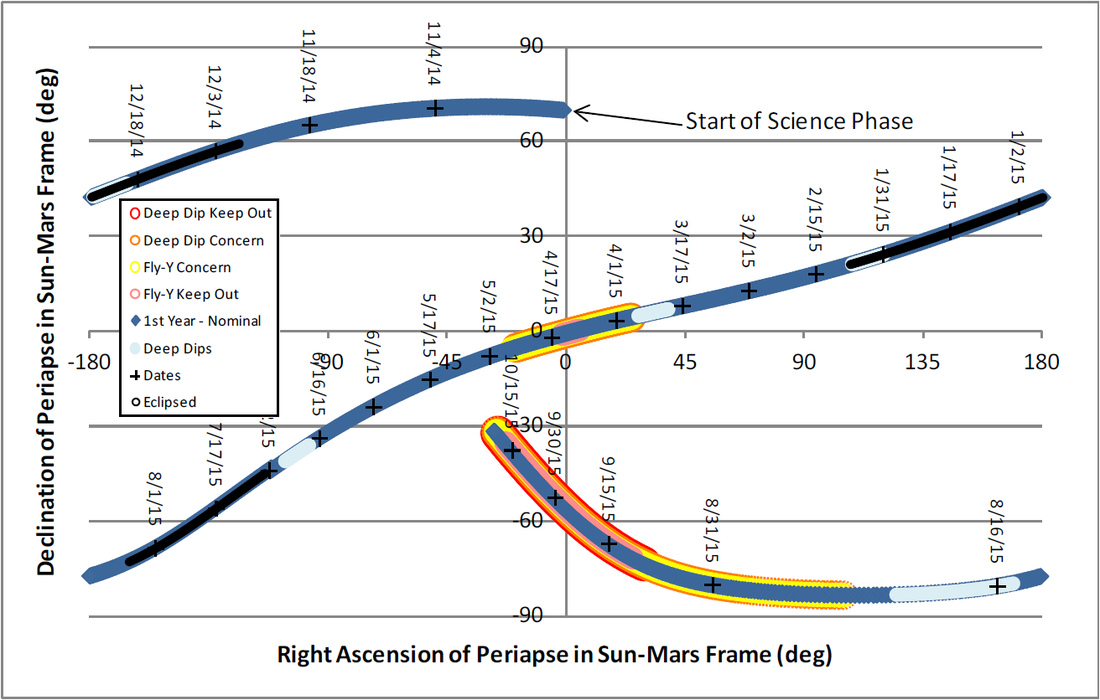
MAVEN’s orbit was designed so that the spacecraft covers all longitudes between +/-75 degrees as the planet rotates below MAVEN’s orbit. The orbit precesses in latitude and local solar time – allowing MAVEN to study local and temporal variations of atmospheric density and composition as well as other properties such as loss processes and the interaction with the solar wind. A one-year science mission in this orbit enables MAVEN to cover near-Mars space very thoroughly.
The figure to the right shows that the one-year science mission provides coverage of all local solar times and most latitudes. The Right Ascension and Ascending Node precess at a rate of 0.6 degrees per day and the Argument of Periapsis drifts by 0.8 degrees per day.
The five Deep Dip campaigns (discussed later) are also spread to cover locations & times of particular interest. MAVEN flies in two different atmospheric regimes – nominal periapse passes in a density of 0.05 to 0.15 kg/km^3 and 2.0 to 3.5 kg/km^3 for Deep Dips.
Solar Conjunction
During Solar Conjunction that lasts about three weeks in June 2015, the spacecraft is sun-pointed with the Articulating Payload Platform parked in Sun Safe Position – suspending science operations for the duration of the conjunction and one week to prepare beforehand and one week to recover the vehicle afterwards. The same applies to Solar Conjunctions that occur during the extended mission.
Communications Sessions
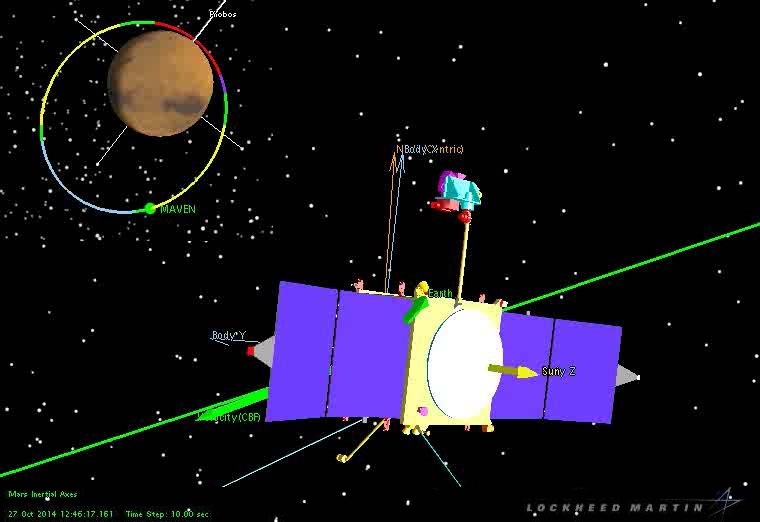
MAVEN’s science phase features regular communication sessions. The spacecraft points its High Gain Antenna at Earth for high data rate communications twice per week with the exact timing depending on Deep Space Network visibility. Those comm sessions take place on Tuesday and Friday and have a duration of eight hours during which at least five hours of Earth pointing are required to downlink all science data and housekeeping telemetry.
For HGA Comm Sessions, MAVEN tracks Earth flying in Earth-pointing mode with the Articulating Payload Platform in a Commanded Position (90 inner/65 outer).
In addition to High Rate Communication Sessions, MAVEN uses its Low-Gain Antennas for Doppler tracking performed by the Deep Space Network as part of 8-hour ranging sessions occurring more frequently to precisely determine the trajectory of the spacecraft for science data processing and maneuver planning.
Deep Dips
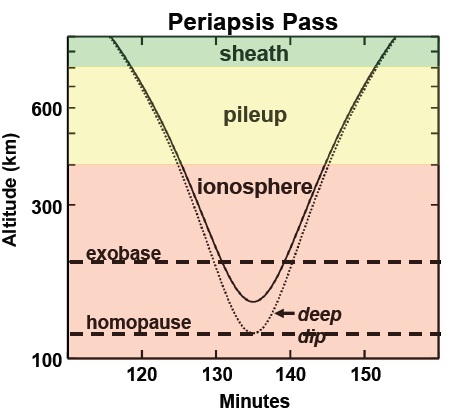
In order to study the Upper Martian Atmosphere in-situ, MAVEN performs a total of five Deep Dip Campaigns over the course of its mission. These campaigns will each be five days in duration and begin with a maneuver at apoapse and reduce the periapse altitude from 150 to 125 Kilometers. In this modified orbit, MAVEN performs five days of science operations, filled with particle measurements in the upper atmosphere.
Those Deep Dip campaigns are planned for December 26, 2014 to cover the anti-solar region, on February 6, 2015 to cover the dusk terminator region, on April 10, 2015 to cover the sub-solar region, on June 26, 2015 to cover the dawn terminator, and on August 21, 2015 to cover the south polar region. The Deep Dips have been carefully set up to cover different regions of interest at different times of day to examine local and temporal variations in atmospheric density and composition.
During Deep Dips, MAVEN flies in Velocity Nadir Attitude with the Articulating Payload Platform in Velocity Track mode, tracking the planer-relative velocity. Deep Dips require a continuous DSN coverage.
At the completion of a Deep Dip Campaign, MAVEN performs another maneuver at apogee to increase its periapsis back to 150 to 170 Kilometers.
Stellar Occultations
In addition to five Deep Dips, MAVEN performs a total of six planned Stellar Occultation Campaigns. To do that, IUVS (Imaging Ultraviolet Spectrograph) is oriented so that a chosen star is imaged into one of two keyholes located at either end of the entrance slit (a Large and Small Occultation Keyhole).
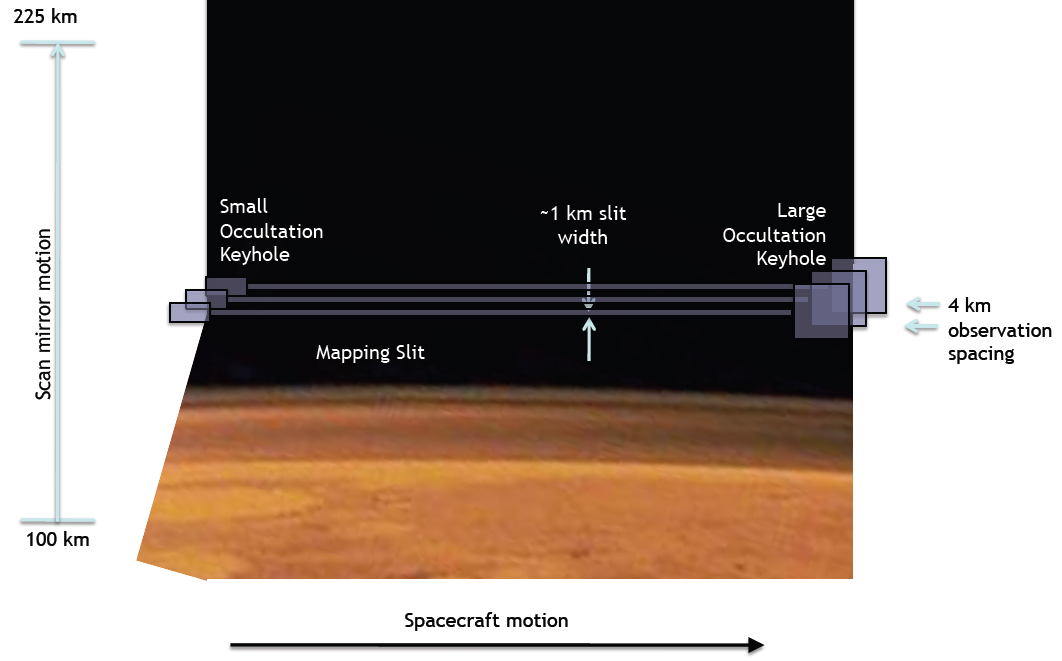
As the spacecraft orbits the planet, the atmosphere passes in front the the star, absorbing its light. IUVS can determine the amount of absorbed starlight to determine the concentration of Carbon Dioxide, molecular Oxygen, ozone and aerosols to characterize the lower atmosphere. Stellar imaging is completed as part of dedicated one-day campaigns occurring once every two months to make five consecutive measurements of one star to achieve full longitudinal coverage as Mars rotates once every five MAVEN orbits.
The campaigns are planned to take place in Week 5 (November 2014), Week 13 (January 2015), Week 20 (March 2015), Week 30 (May 2015), Week 40 (August 2015 ) and Week 52 (October 2015).
For Stellar Occultations, MAVEN is placed in Inertial Hold attitude mode with the S/C axis pointing towards the selected star with APP pointing the IUVS field of view at the star.
In between Deep Dips and Stellar Occultation Campaigns, MAVEN performs a total of five Magnetometer Roll Calibration campaigns over the course of the science mission.
Science Scenarios & Operation Modes
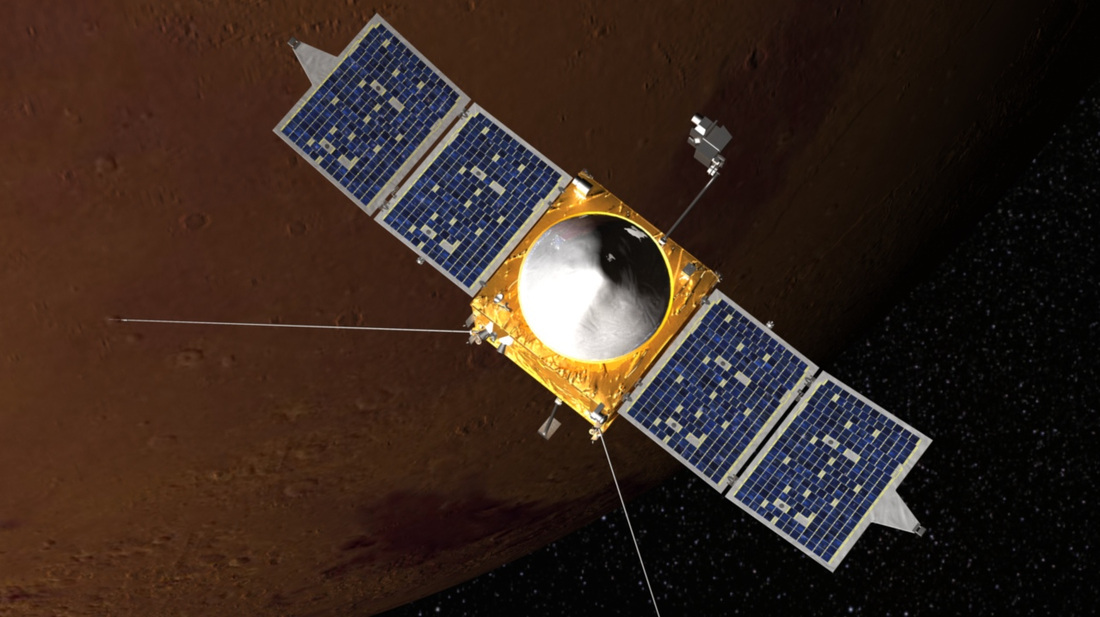
MAVEN uses a number of science scenarios that feature operations of all instruments during the Periapse Segment (IUVS and STATIC alternate) and operations of selected instruments, LPW/EUV, Magnetometer, SWIA, SWEA are also performed during other orbital segments.
When MAVEN is around apoapse, far from the Planet, the spacecraft passes through near-Mars space, enabling it to measure the solar wind. Non-thermal ions and electrons are measured continuously using SWIA, SWEA, STATIC and SEP. The Magnetometer is also active to study the magnetic field far from Mars. While in sunlight, the EUV instrument measures Extreme Ultraviolet Radiation to study solar wind phenomena. Also at apoapse, the Imaging Ultraviolet Spectrometer performs atmospheric disk measurements.
While on its inbound or outbound legs from and to periapse, the spacecraft uses IUVS to make Coronal scans. As MAVEN gets closer to Mars, it enters the Sheath and Pileup regions in which the STATIC instrument is used to monitor atmospheric escape along with LPW measurements of the ionosphere.
Around periapse, the spacecraft is most active – using most of its instruments to study the Martian atmosphere. The Neutral Gas and Ion Mass Spectrometer makes in-situ particle measurements while LPW studies the electric and magnetic environment, IUVS performs limb scans and STATIC is also active studying loss processes.
In addition to this basic science sequence, the MAVEN mission features a number of prepared science scenarios that will be used based on limitations including sunlight, attitude and other operational constraints:
-
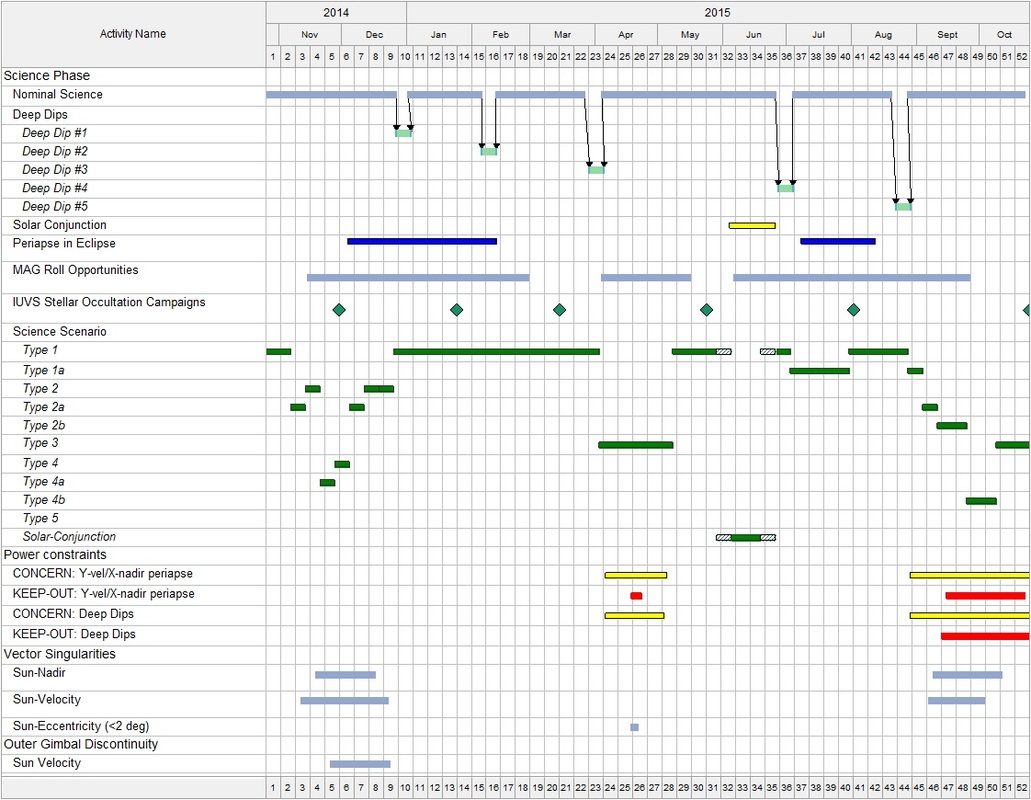
MAVEN Science Plan (Click to enlarge) – Image: NASA/LASP In its primary science mode, MAVEN will alternate operations in a two-orbit scheme. For both apoapse passes, MAVEN performs IUVS Disk Scans. The Side Segments on the first orbit are dedicated to IUVS Coronal Scans while the sides on the second orbit feature STATIC Sun-nadir pointing. For the first Periapse Segment, MAVEN is in Fly-Y attitude (minimal spacecraft surface area in the direction of atmospheric drag flow – S/C +/-Y axis in velocity direction, +X pointing nadir, Solar arrays seen on edge by the atmosphere). During Fly-Y, the Articulating Payload Platform is pointing Ram-Nadir. On the second periapse, MAVEN flies in Sun-Velocity attitude (spacecraft pointing towards the sun, +Z axis to sun, +/-Y towards velocity direction) and the APP in Ram-Track position.
-
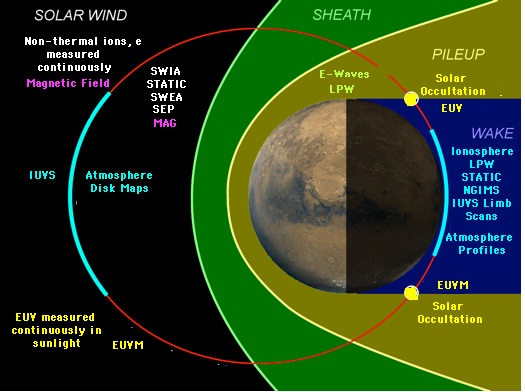
Image: NASA/LASP Science Mode 1a substitutes the first APP Ram-Nadir pointing with the Ram-Horizontal position for STATIC operations during periapsis.
- Science Mode 2 is used when the attitude singularity precludes use of the sun-pointing mode during periapse – meaning that the vehicle and APP orientation during the second periapse are switched to Fly-Y and either Ram-Nadir (2) or Ram-Horizontal ( 2a) or Fly-Z on both periapse passes (maximal surface area in drag flow, -Z in velocity direction, +X pointing nadir, back of the inner solar arrays are seen flat-on by the atmosphere) with APP Ram-Nadir pointing (2b).
- Science Mode 3 is used during power constrained mission periods with MAVEN is in sun velocity attitude at all times and APP pointing Ram-Track on all periapse passes.
- Science Mode 4 is used when attitude singularities prevent the use of side segment sun-nadir and periapsis sun-velocity pointing. It features the nominal scenario on the first orbit and the apoapse of the second orbit while the slides of the second orbit feature IUVS Coronal Scans and the periapse features Fly-Y and Ram-Nadir pointing. Scenario 4a features Fly-Y with APP in Ram-Horizontal to enable STATIC observations. In Scenario 4b used when simultaneous constraints prevent the use of Fly-Y and Sun-Velocity, MAVEN flies in Fly-Z on both periapse passes and always performs IUVS Coronal Scans with APP in Ram-Nadir.
- Science Mode 5 is utilized during power constraints and simultaneous preclusions of side-segment nadir mode. It features IUVS observations on all sides with MAVEN in Sun-Velocity attitude during periapse and APP pointing Ram-Track.
These scenarios are alternated over the course of the one-year science mission and the extended mission. MAVEN spends most of its mission in Science Mode 1 while the other scenarios are used when needed based on spacecraft attitude limitations.
Extended Science Mission
At the conclusion of the MAVEN science mission after one year, the spacecraft enters an extended mission that is driven by spacecraft and instrument status as well as operational constraints. The limiting factor for the mission is likely going to be propellant that is used throughout the mission for corridor control, reaction wheel desats and propulsive maneuvers (TCMs, MOI + possible re-start, period reductions, orbit adjustments, Deep Dips).
Without any unexpected events, MAVEN has plenty of fuel margin to perform several years of extended science operations. The current plan is to continue science operations in the low-periapse orbit for 29 months after the completion of the primary mission. After that, the vehicle would raise its periapse to extend its orbital lifetime and slow down orbital decay. In that orbit, MAVEN could operate for up to six additional years performing a combination of science operations and rover communications relay. Extended mission time can be traded for additional deep-dip campaigns during the 29 months of extended science if deemed necessary by scientists.
Assuming a nominal primary and extended mission, MAVEN would remain operational in Mars orbit until 2022 or even beyond.
